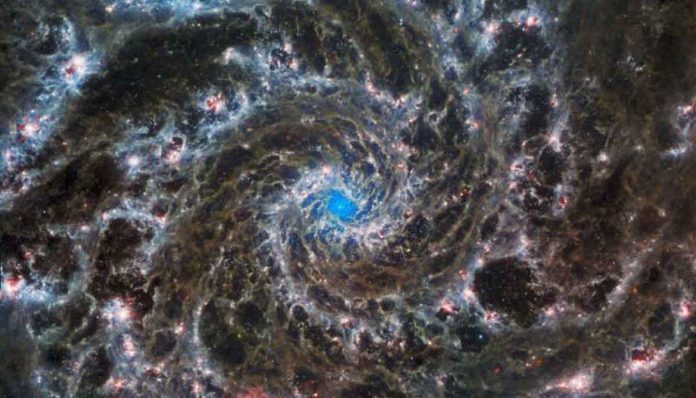In a new image released by NASA and the European Space Agency, the James Webb space telescope revealed dazzling new detail of a previously known slice of the cosmos 32 million light-years away (ESA).
The telescope’s infrared technology, which was launched in December 2021, has provided astronomers with a clearer view of the so-called Phantom Galaxy than they had previously seen.
“Webb’s sharp vision has revealed delicate filaments of gas and dust in the grandiose spiral arms that wind outwards from the centre of this image,” NASA and the ESA said in a joint statement Monday.
“A lack of gas in the nuclear region also provides an unobstructed view of the nuclear star cluster at the centre of the galaxy,” the agencies said in a statement.
The whirling celestial form, officially known as M74, is 32 million light-years away from Earth in the Pisces constellation.
The Webb image depicts the galaxy’s brilliant white, red, pink, and light blue dust and star appendages swirling around a bright blue centre, all against a dark background of deep space.
M74 was previously photographed by Hubble, which captured the spiraling blue and pink arms of the galaxy but showed its glowing centre as a soft yellow.
According to NASA and the ESA, the Phantom Galaxy is a “favorite target for astronomers studying the origin and structure of galactic spirals.” Webb’s image will help them “learn more about the earliest phases of star formation in the local Universe” and collect more data on 19 star-forming galaxies near our own Milky Way.
According to the statement, astronomers will use the image to “pinpoint star-forming regions in galaxies, accurately measure the masses and ages of star clusters, and gain insights into the nature of the small grains of dust drifting in interstellar space.”
Webb’s new images have wowed the space community as the telescope orbits the Sun at a million miles (1.6 million kilometers) from Earth in a region of space known as the second Lagrange point.
NASA, the European Space Agency, and the Canadian Space Agency collaborated on the telescope, which has a primary mirror that is more than 21 feet (6.5 meters) wide. It is expected to be operational for about 20 years.

